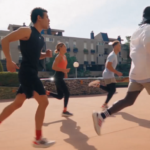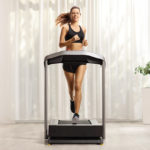This article originally appeared in American Fitness Magazine’s Spring 2020 issue.
Can you use the same ideas that personal trainers use when they train their clients one-on-one? You may have attended a fitness event with amazing programming ideas, or read an article that featured novel moves that you would like to incorporate. However, the source was focused on trainer-client workouts.
Even if you weren’t the target audience, you can still benefit from one-on-one training. You can adapt personal training moves and ideas to the group fitness environment with a little creativity and a few small adaptations.
Limiting Factors & Possible Solutions
Let’s first look at the challenges of implementing one on one workouts within a group, as well as viable class conversions.
LIMITING FACTOR : Insufficient or improvised setup
Resistance tubing is often incorporated into online tutorials and presentations. The trainer will usually anchor the tube on a wall hook to accommodate the client. There are few hooks on the wall in classrooms, and even fewer that have the number or location needed to give multiple people a complete workout. You’re unlikely to find hooks at chest level for rows or high enough to do triceps-kickbacks. There may also not be space to allow participants to step away to reduce slack. Tubes are a great piece of equipment for group classes. They’re inexpensive, effective and popular. Tubing must be secured further away from the anchor than is possible with self-anchoring for moves such as the ones shown here. The anchor should be strong enough for the user to push and pull. Try one (or both!) of the following solutions rather than giving up on resistance tubing exercises. Try one (or both!) of the following solutions.
Partner up. Participants should be paired with people of similar height or fitness level. Partner 1 holds the tubing while Partner 2 performs the movement, moving far enough from Partner 1 in order to create tension. The partners should then swap places. You need to know your group, and you must be confident that everyone can safely handle the resistance provided by the person working. A word of caution: Partnering is not safe if you are working with groups that are frail, have arthritis, or who may be at high risk.
If available, use ballet bars. There are some group fitness rooms that have ballet bars permanently anchored to the wall. Portable bars won’t work. Wrap the tubes around bars and space class members accordingly. You can adjust the position of the participants, but not the height of the bars. Kneel down on the floor to perform triceps Kickbacks. Ask the taller people for alternate rows of squats or lunges and ask the shorter people to stand tall.
Not Enough Equipment
Trainers only need one piece of equipment for each client. There may be 20 students in your class, and you have more than 100 dumbbells with different weights. However, there are only a few stability ball, yoga blocks or Pilates rings. You may find that your options are limited to dumbbells or body weight drills. Let’s say that you want to use stability balls in your workouts, but there are only 20 at the club and some of them are lying on the floor being used by clients and trainers. You have several options.
Partner up. Partner up. As long as there are at least 10 balls available, you can alternate partners. Partner 1 will use the ball while Partner 2 performs a free weight exercise or waits for her turn. Avoid three-person groups because the members will either have to wait for too long or the set up will be messy. If Partner 1 is on the move, Partner 2 uses free weights, and Partner 3 is waiting, then they will get confused when rotating.
Create a circuit. Set up a circuit if you only have 10 balls to accommodate 20 people. You might also have four balls that are weighted, tons of free weights, and four bands. Set up five stations, each with four people, four pieces of equipment, and do the math.
Take turns in teams. If you only have 10 of the desired equipment, but not 20 units, divide the class into 2 teams. Set up 10 stability ball on one side and free weights in the other. Switch teams only after several consecutive exercises, not sooner, to maximize efficiency. Switch teams after Team 1 has completed three or four exercises using balls and Team 2 with free weights.
LIMITING FACTOR : GATHERING ACCURACY FEEDBACK
Working with a personal trainer can provide clients with immediate feedback and specific information that they can use to modify their workouts in real-time. Trainers regularly check in with clients, asking questions like “How do you feel about this intensity?” or “Compared to last week, what is your energy level?”
These open-ended questions provide the necessary information to adapt the workout. Imagine the cacophony if such questions were asked to a group. You’d have to decipher all the responses if you asked, “What type of music do like?” or “Let’s know how you feel.” Try the following methods instead:
Ask for a vote or hand-raise to close-ended questions. Say, “Put your hand up if this intensity/progression/complexity (whatever you want to establish) is just right/too much/too little” or “Hands up if your energy seems higher/lower/the same today compared with last week.” Craft questions that require a yes or no vote. You can’t satisfy everyone’s needs, but you can offer options based on responses. “If you raised your hand for yes, do option A. If you voted for no, option B is right for you.”
Offer personalized attention by walking around the room. Take a walk around the room to offer personalized attention if the format allows it. Stand next to someone who is demonstrating a modification, and encourage others to follow their lead. If you think someone needs help or is struggling with something, quietly approach her and ask a few questions.
LIMITING FACTOR : Not enough space
Some moves need a lot more space. We’ve seen clients doing lunges, ladder drills or sled pullings on the gym floor. One person may be moving through halls, machines or openings in the gym. How can you incorporate “big space” moves in a group?
You can save big moves to days when attendance is low. You may have to give up on creative solutions at times and just save your travel moves for days with low attendance. Every teacher has days where few students show up to class. No matter what the reason is (such as a holiday or traffic delay), you can use the low numbers to introduce “big space” movements into your classroom.
Bring your class outdoors. Consider doing an outdoor drill if the weather is good and your facility has a large, open space nearby. Verify with the management if this is within policy.
These adaptations are simple and easy but not always obvious. Think “outside the box” in your classroom if you’ve seen trainers do cool things with clients.
Sample “Limited-Equipment” Drill
You have 10 stability ball, plenty of dumbbells and some new personal training exercises that you learned in a recent conference. There are also about 20 participants. What should you do? Divide the class in two teams. Place the weights and balls on opposite sides of the room. After completing several consecutive exercises, switch teams and teach the following moves.
Team 1: Stability ball
Then, switch sides and repeat the exercises.
Pike on the Ball, 12x
Write your thoughts by sitting on a ball.
Full name in cursive
Begin by seated on the ball. Do 12 reverse squats. Only raise your legs high enough to keep some contact with the ball.
Team 2: Dumbbells
Lunges and biceps, 12x.
Bridge and chest presses, 12x
Transfer weight from left to right while squatting with a dumbbell woven around your legs in a figure eight pattern.
Reverse direction.










